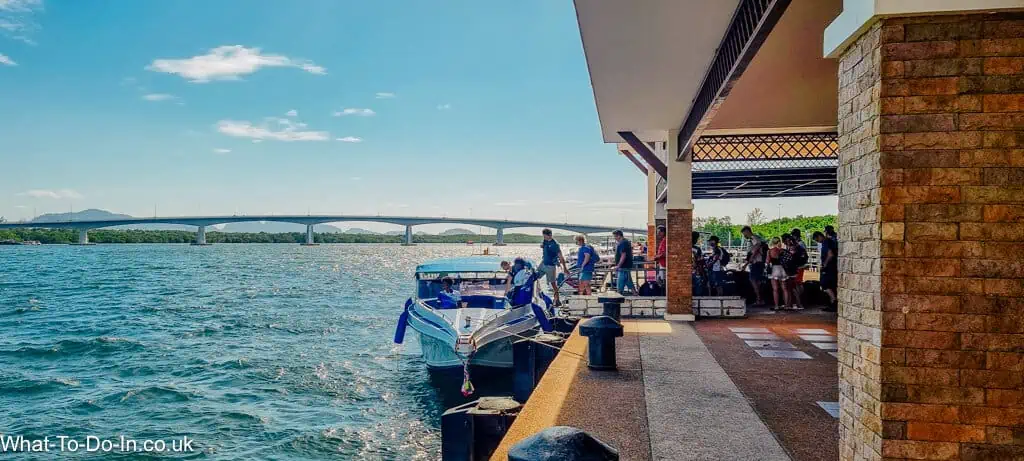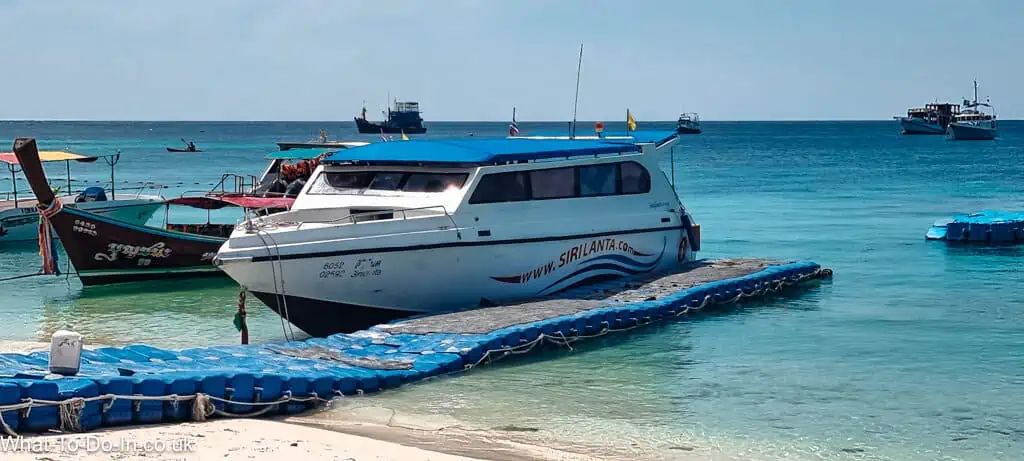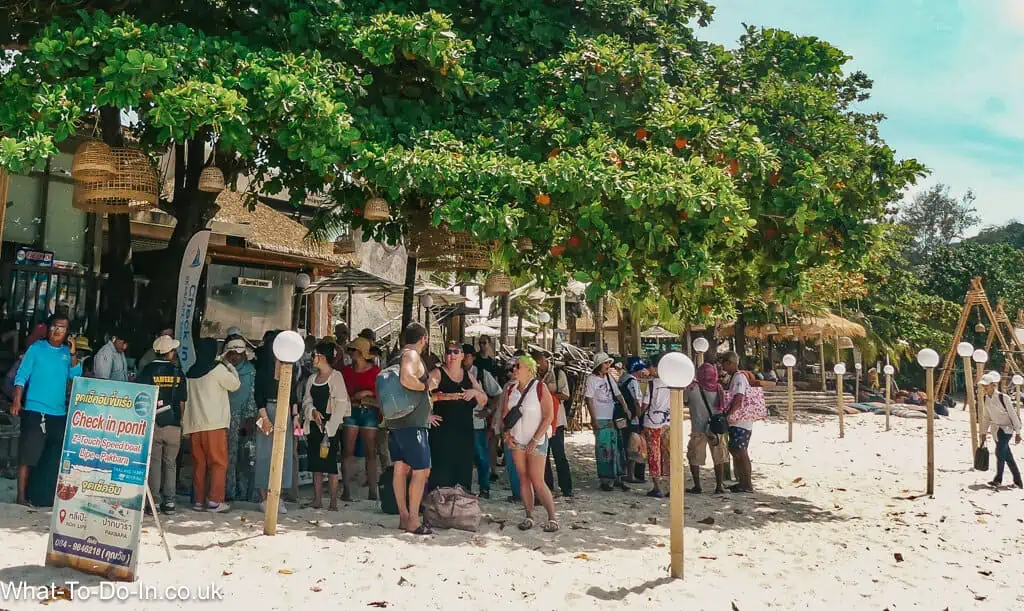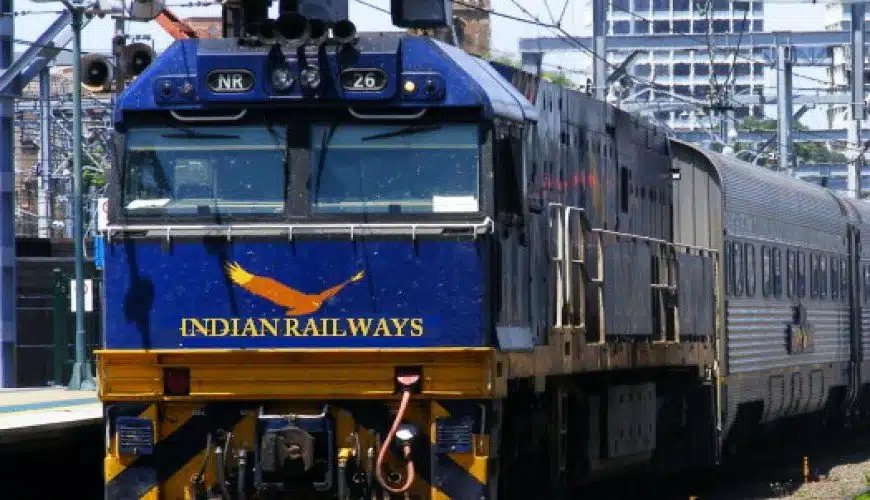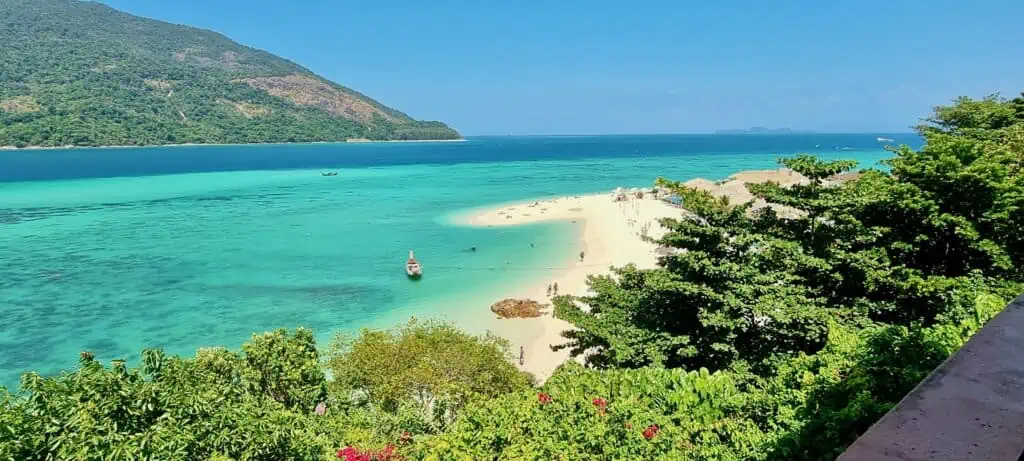There are many routes and types of transportation that can be used to get to Koh Lipe, a beautiful island paradise in Thailand’s Andaman Sea. The island can be reached from both Thailand and Malaysia. When we first thought about going to Thailand, Koh LIpe was the first place Aidan said he wanted to go. I spent a lot of time researching all the different ways we could travel to the island. As it turned out, we didn’t go to Koh Lipe the first year we were in Thailand but the following year we did make the journey. Although I had looked at so many different ways to get to Koh Lipe in the end we chose one of the simplest options and took a speedboat from Koh Lanta. Our journey to Koh Lipe was an ordeal but the return trip was not as bad.
How to Get to Koh Lipe
Koh Lipe is an island, so any trip there will involve travelling on a boat. There isn’t an airport on the island, so there are no direct flights to Koh Lipe. If you are coming from Thailand, it can be a long journey as Koh Lipe is in the far south of the Andaman Sea. It is a shorter trip from Malaysia, but you will have to go through an immigration check, and you will need the necessary paperwork.
Your trip will probably involve several stages and modes of transport. You can book the different stages of the journey individually yourself, or you can buy them as a package through a travel company. Your hotel or resort in Koh Lipe may also have travel packages.
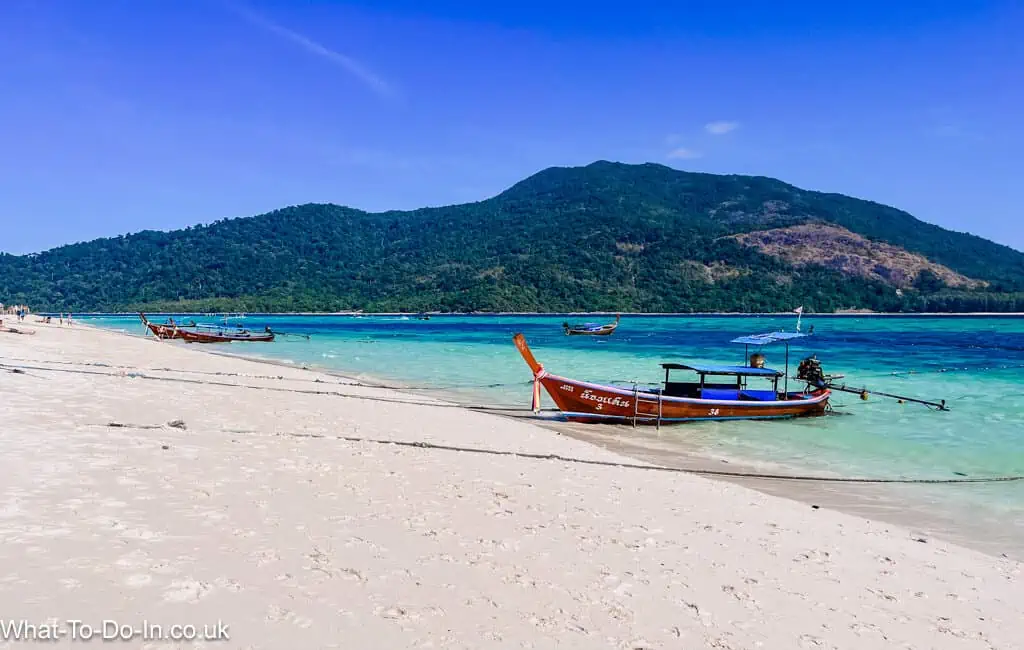
Our Personal Experience of Travelling to Koh Lipe
We booked a direct speedboat ticket to Koh Lipe from Koh Lanta online with Tiger Ferry. Our departure time on the ticket was 10:30 am, and we were expecting to land around 1 pm. The check-in desk was easy to spot, and we joined a line of passengers. We had all our information printed out and we were processed very quickly. People in front of us in the queue who only had their details on their phones took a lot longer. We were given a clipboard to add our names to the list and then given a sticker with ‘KL’ and a number written on it, which we were instructed to stick on our tops where it could be clearly seen. We checked in at about 9:30, and there were only about eight names above ours on the list, but our numbers on the stickers were 211 and 212.
We walked past a barrier and onto Sala Dan Pier. The pier is T-shaped, with boats pulling up on all sides. There was a roof to provide shade and several rows of seats. Since we would be sitting on a boat for hours, we chose to stand. We put our bags down near a pillar and tried to get our bearings. We had expected some kind of signage to indicate the destination of the boats as they arrived and departed. We soon discovered that there were no signs, no announcements and, as far as we could see, no logical system. Boats from the same company tied up at different ends of the pier and ferries to the same destination left simultaneously but from different mooring berths. We tried asking people wearing staff uniforms where we would be going from, but they were less than helpful.
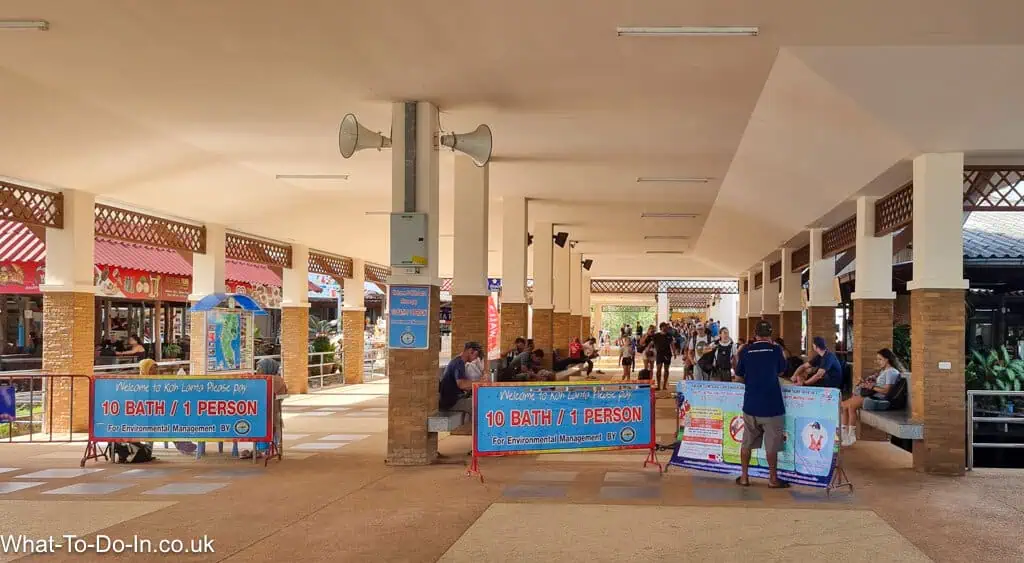
As you can imagine, this was quite stressful. Although Sala Dan isn’t a big pier, there were usually at least five boats arriving and departing, and it seemed likely that we could miss our boat in the confusion. We weren’t the only passengers worrying about where we were supposed to be, as no one seemed to have been given any directions. We eventually found other people with the same stickers as ours and stood together in a group. If anyone who looked like staff came near us, someone would ask for help only to be given the same vague replies.
Onboard the Speedboat
Then, at about 10:15, we were told to go to the right-hand end of the pier. A boat had been tied up there for a while, and we were told to put our bags near the edge and join the queue. (I am obviously using the word ‘queue’ loosely). Then, for reasons that were never made clear, we were told to stand to one side and identify our bags. We were directed onto the boat with about 20 other passengers, and our bags were loaded on board. One of the staff members had a clipboard, and he went around everyone checking our stickers. A couple of people were missing, but they were quickly located, and we set off, leaving the majority of our fellow travellers on the pier.
At first, everyone was very happy that we were underway almost exactly on time. The speedboat only had three sets of two seats in the middle facing forward, so most of us were sat on the two benches running sideways down the boat. A life jacket was provided for each passenger, but most people stuffed them under their seats or sat on them. We went under the bridge to Koh Lanta Noi and inside Koh Talabeng. A lot of people stood up to enjoy the views as the boat slowly made its way past the mangrove groves.
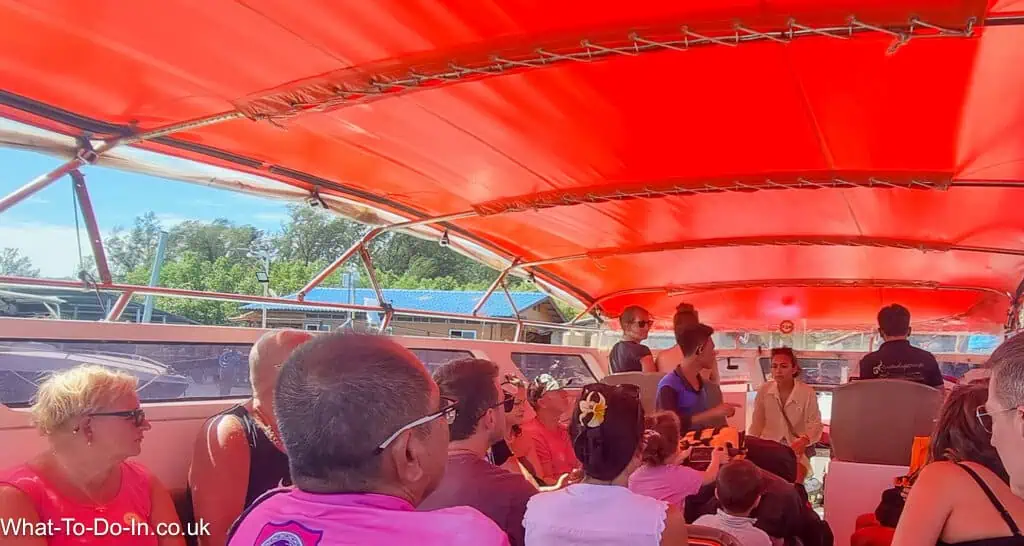
We had noticed that most of the other passengers had stickers with different initials to ours, and from conversations, we knew they were heading to Koh Muk, not Koh Lipe. We realised this would mean we were not going directly to Koh Lipe, but we hoped it wouldn’t make the journey longer.
Heading Out to Sea
As we headed out into the open sea the speedboat increased its speed. There were only two engines on the back of the boat, and it was one of the smallest speedboats used for ferries. As soon as we went faster, waves of seawater came splashing in through gaps between the tarpaulin roof and the sides. One of the boat crew worked around the boat, securing flaps over the gaps. While this reduced the amount of water coming in, it also reduced the airflow, so the smell of the engine fuel became much stronger. Pretty much everyone onboard had ended up getting soaked by the waves, and we were glad we had put all our electronics in a sealed bag as a precaution.
The other noticeable difference was the waves. It was a windy day, and the waves were big. Our small boat was smacking into them several times a minute. Each time we hit a wave, it felt like slamming into a wall, followed by the boat dropping a couple of feet. I could see the pilot from where I was sitting; he was working hard to adjust our course to avoid the worst waves. Despite his best efforts, we crashed into wave after wave. It was relentless and incredibly tiring. Some people fished out their lifejackets and put them on. Everyone was sliding on the bench seat, especially as we were wet from the waves. So, we constantly had to readjust our position to stay in place. The jarring feeling as we bounced up and then smacked down into our seats was uncomfortable at first but soon became painful. On top of this, the engines were working hard, so they were very loud, and the smell of engine fuel was overpowering.
No one was talking or chatting as it was impossible to be heard without shouting in your neighbour’s ear. People tried various positions to get more comfortable, including standing and lying down, but nothing improved the ride. All we could do was brace ourselves against something nearby, clench all our muscles and hope it would soon be over. There was a family with two small children, and somehow, the toddlers managed to sleep most of the way, cradled by their parents.
After about an hour, we approached an island. I presumed it was Koh Muk, but I was wrong – it was Koh Ngai. Several people were getting off and on, and instead of trying to see what was happening, we took the opportunity to have a drink of water and to try and make ourselves more comfortable. I use a travel sickness kit as a precaution. It contains herbal patches to stick behind your ears and wristbands with buttons that you line up with pressure points. I have never been affected by seasickness while using these – it might be psychosomatic, but it works, so I don’t question it. I also dug out some mints to try and counteract the engine fumes. We were soon underway again, but it was quite cramped as more people had got on than had got off.
After about half an hour, we arrived at Koh Kradan. This had one of those awful blue floating jetties. It was very long, and with the wind and big waves, it took a while to get moored up. The jetty was bobbing up and down unpredictably. Passengers were being helped down the jetty supported by a man on both sides, and I saw one man crawling along. A big ferry pulled up near us, but rather than use the jetty, they chose to give all their passengers life jackets and have them jump into the sea and wade/swim ashore. With difficulty, staff manhandled people’s luggage onto the jetty. One of our boat crew fell off the jetty into the sea. It wasn’t easy for him to get back onto the boat; his top was torn and dirty, and he was obviously bruised. I was very glad we weren’t going ashore at Koh Kradan!
We set off again and moored up at another island. This time, it was Koh Muk. There was a pier here, so it was much easier for people to disembark. Most passengers got off, and only a couple got on, so there was much more space. By this time, it was after 1 pm, which was when we had been hoping to arrive on Koh Lipe. We set off again, and everyone had stickers with ‘KL’ for Koh Lipe, so we guessed there would be no more detours.
Finally Heading for Koh Lipe
As bad as the journey had been it now got even worse. We were constantly crashing into waves with no respite. Several people were on the verge of tears, and everyone looked unhappy. All we could do was endure it as best we could. There was no shelter from the islands or the mainland, and our boat was battered from all sides. I was trying to keep track of our progress with a map app on my phone, but seeing how far we still had to go was depressing. It took nearly three hours to finally arrive on Koh Lipe. We moored up to a floating blue jetty, but thankfully, Pattaya Beach was sheltered, and the jetty was short, so it wasn’t difficult to get ashore. In total, it took us over five hours to get to Koh Lipe.
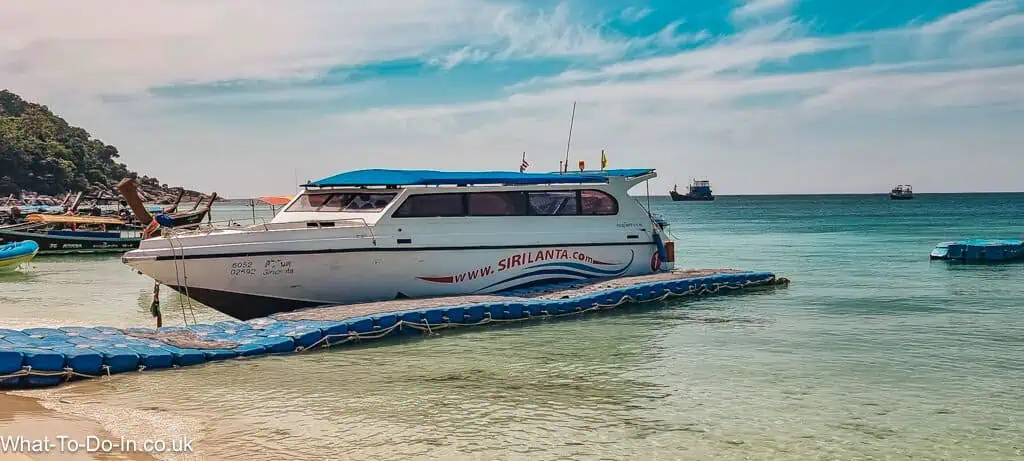
Obviously, we had an unusually bad trip to Koh Lipe. The winds were strong, the waves were high, and we were on a small, two-engine boat that stopped at almost every island on the way. Our return journey was direct and took two and a half hours as advertised. It was a bigger boat with four engines, and it had seats in rows facing forward, which were much more comfortable than sliding off a bench. It was still quite windy, but we only seemed to slam into a wave every five minutes. When we went to Koh Libong, we again had seats in rows on a four-engine boat, and we only hit a wave every quarter of an hour or so. For our return from Koh Libing, we were in a small speedboat with benches down the side. We managed to get one of the few seats facing forward. The sea was very calm this time, and we didn’t smack into any waves. Despite stopping three times, we arrived back on Koh Lanta half an hour ahead of schedule.
On a calm day with few big waves and a reasonably sized boat with seats travelling by speedboat, it is boring but OK. On a bad day, it is awful. Sadly, there is no way to predict what weather you will have, what size boat you will be travelling on and how many times you will stop along the way.
Getting to Koh Lipe by Ferry
Travelling on a ferry is how we got to Koh Lipe and it is probably the most common way to get there. It’s an island so sooner or later you have to get on board a boat. There are several ports offering ferry or speedboat services to Koh Lipe. The nearest departure points are:
1. Pak Bara Pier
- Location: Satun Province, Thailand
- Details: Pak Bara is the main and most frequently used port for trips to Koh Lipe, with year-round ferry and speedboat services. It offers the most direct and fastest routes to the island.
- Travel Time to Koh Lipe: About 1.5 hours by speedboat and slightly longer by ferry.
2. Kuala Perlis Pier
- Location: Perlis, Malaysia
- Details: Kuala Perlis offers an alternative route, especially if you are coming from Malaysia. However, there are few direct ferries from Kuala Perlis to Koh Lipe, and you will probably have to change boats in Langkawi.
- Travel Time to Koh Lipe: Typically around 4.5 hours by ferry, including a 2-hour layover in Langkawi, depending on schedules and the weather.
3. Kuala Kedah Pier
- Location: Kedah, Malaysia
- Details: Similar to Kuala Perlis, Kuala Kedah is a departure point mainly for ferries to Langkawi. You can then take a direct ferry from Langkawi to Koh Lipe during the high season.
- Travel Time to Koh Lipe: Typically around 4 hours by ferry, including an hour layover in Langkawi, depending on weather conditions and timetables.
4. Langkawi (Telaga Harbour Marina or Kuah Jetty)
- Location: Langkawi, Kedah, Malaysia
- Details: Langkawi is the main departure point for Koh Lipe from Malaysia, with direct ferries and speedboats available during the high season (typically from November to April).
- Travel Time to Koh Lipe: Usually around 1.5 hours by ferry, depending on the weather and the type of boat.
Koh Lipe Flights
If you don’t like travelling by boat you are probably hoping there is an airport on Koh Lipe. Sadly there isn’t! These are the nearest airports to Koh Lipe:
1. Hat Yai International Airport (HDY)
- Location: Hat Yai, Songkhla, Thailand
- Distance to Koh Lipe: Approximately 130 kilometres to Pak Bara Pier, the main departure point for ferries and speedboats to Koh Lipe.
- Travel Time to Pak Bara Pier: Around 1.5 to 2 hours by road.
- Connections: There are a range of domestic flights from Bangkok and other Thai cities, as well as some international connections. Thai AirAsia, Bangkok Air, Thai Lion Air, and Thai Vietjet all fly into Hat Yai Airport. Minivan transfers, taxis, and bus services to Pak Bara Pier are available from the airport.
2. Trang Airport (TST)
- Location: Trang, Thailand
- Distance to Koh Lipe: Roughly 120 kilometres to Pak Bara Pier.
- Travel Time to Pak Bara Pier: About 1.5 to 2 hours by road.
- Connections: Primarily serves domestic flights from Bangkok. Thai AirAsia, Thai Lion Air, and Nok Air have flights to Trang Airport. Road transfers to Pak Bara Pier can be arranged via taxis, minivans, or buses.
3. Langkawi International Airport (LGK)
- Location: Langkawi, Kedah, Malaysia
- Distance to Koh Lipe: Direct ferries from Langkawi to Koh Lipe are available during the high season (typically November to April), making it a practical option for flights to Koh Lipe.
- Travel Time to Koh Lipe: Around 1.5 hours by ferry, available seasonally.
- Connections: There are both domestic flights within Malaysia and international flights from select destinations. AirAsia has regular flights from Bangkok, and Malaysia Airlines flies into Langkawi Airport from several cities. The ferry terminal for departures to Koh Lipe is close to the airport.
When planning your trip to Koh Lipe, consider the season, as this affects the availability of direct ferries from Langkawi. Hat Yai and Trang airports are year-round options, but you will have to travel by road to reach Pak Bara Pier for the final leg to Koh Lipe by sea.
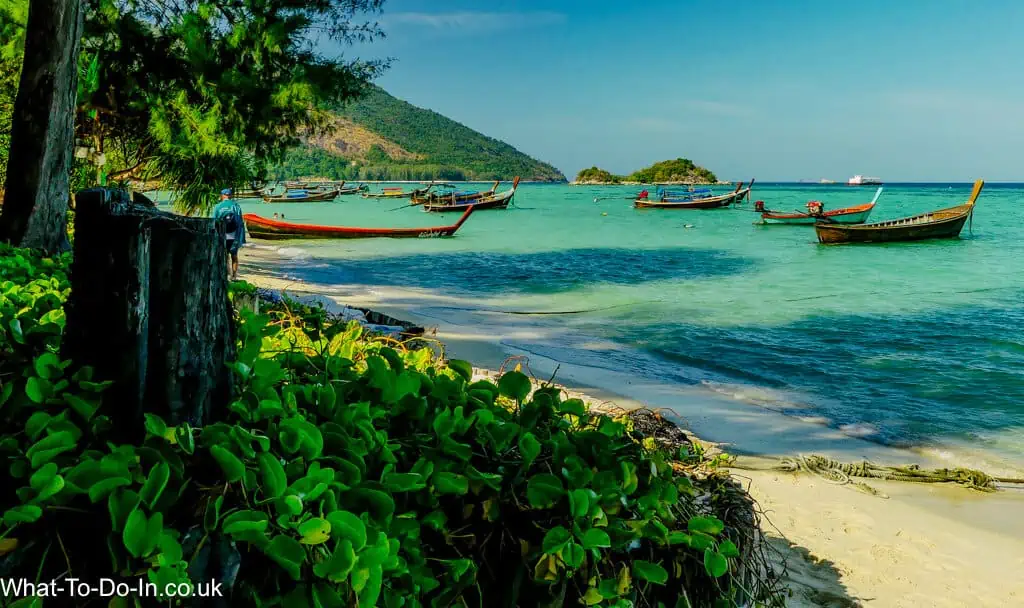
Getting to Koh Lipe by Train
I really liked the idea of travelling through Thailand by train to the nearest ferry port for Koh Lipe. It seemed like a great, stress-free way to see the countryside. However, Thai trains are not very fast and they can not be relied on to run on schedule. Trying to connect to a ferry seemed problematic so you realistically you would have to book an overnight stay. This adds to the expense and hassle so in the end we decided not to attempt using the trains. The nearest train stations to Koh Lipe are located in Thailand. These are the main stations if you want to go to Koh Lipe by train:
1. Hat Yai Junction Railway Station
- Location: Hat Yai, Songkhla Province, Thailand
- Details: Hat Yai Junction is the largest railway station in Southern Thailand and is a major transport hub for the region. It’s connected to Thailand’s national railway network, which allows for travel from Bangkok and other parts of Thailand.
- Distance to Koh Lipe: Approximately 130 kilometres to Pak Bara Pier, where ferries and speedboats depart for Koh Lipe. After arriving at Hat Yai Junction, you can take a minivan, bus, or taxi to Pak Bara Pier to catch a ferry or speedboat to Koh Lipe.
- Travel Time to Pak Bara Pier: About 1.5 to 2 hours by road.
2. Trang Railway Station
-
- Location: Trang, Trang Province, Thailand
- Details: Trang Railway Station is part of the Southern Line of Thailand’s railway network, with connections to Bangkok and other parts of the country.
- Distance to Koh Lipe: Roughly 120 kilometres to Pak Bara Pier. Similar to Hat Yai, passengers can continue their journey to Koh Lipe by taking a road transfer to Pak Bara Pier and then boarding a ferry or speedboat to the island.
- Travel Time to Pak Bara Pier: About 1.5 to 2 hours by road.
Both Hat Yai and Trang stations offer practical options if you are looking to use train travel to get to Koh Lipe. The train journey provides a scenic route through Thailand’s countryside, adding a unique experience to the journey. Prices for train travel in Thailand are not expensive and the trains have air-conditioning. Upon reaching either Hat Yai or Trang, the next step involves a road transfer to Pak Bara Pier, followed by a sea crossing to Koh Lipe.
Going to Koh Lipe in Luxury
Our journey to Koh Lipe was so horrendous that Aidan spent most of our first day on the island trying to find an alternative way back to Koh Lanta that didn’t involve getting on a speedboat. He found several very expensive ways we could have returned. Sadly, our budget was limited so we couldn’t find any viable options. My dream of travelling in a seaplane will have to wait for another day!
However, if you can afford it, there are a few alternative ways to get to Koh Lipe. You could charter a private boat. Both sailing boats and speedboats can be hired transport you on a luxurious, private journey to Koh Lipe. While a speedboat would be faster, booking a sailing yacht or catamaran would be a fantastic way to get to Koh Lipe. You may be able to book a flight on a seaplane although it’s not clear when this service will be available – in January 2023 they said ‘soon’. There is a helipad on Koh Lipe, so it may be possible to take a helicopter trip. As far as we could discover though, the helipad is only used for medical emergencies.
Going to Koh Lipe From Thailand
Since Koh Lipe is part of Thailand, you do not need any extra visas or immigration papers to travel there. This can make it simpler. However, it can be a long journey because Koh Lipe is located in the Satun Province in the far south-west of Thailand. Koh Lipe is approximately 70 kilometres or 43.5 miles from the nearest point in mainland Thailand, the town of Pak Bara in Satun Province
Bangkok to Koh Lipe
While we loved our time in Thailand’s capital, Bangkok, it is a very busy city. Combining time in Bangkok with a trip to somewhere quieter and chilled like Koh Lipe would be a great idea. It is pretty straightforward to get from Bangkok to Koh Lipe.
1. Flight + Ferry/Speedboat
- Flight to Hat Yai or Trang: The fastest way to Koh Lipe is by flying from Bangkok to Hat Yai Airport or Trang Airport. Multiple airlines operate daily flights from Bangkok’s Suvarnabhumi Airport (BKK) and Don Mueang Airport (DMK) to these destinations.
- Transfer to Pak Bara Pier: From either Hat Yai or Trang, you’ll need to take a minivan or bus to Pak Bara Pier, which takes about 1.5 to 2 hours from Hat Yai and slightly longer from Trang.
- Ferry or Speedboat to Koh Lipe: From Pak Bara Pier, you can catch a ferry or speedboat to Koh Lipe. The journey takes about 1.5 hours by speedboat and slightly longer by ferry. Services are seasonal, with more options available during the high season (November to April).
2. Bus + Ferry/Speedboat
- Bus to Pak Bara Pier: If you are on a tight budget, you can take a bus from Bangkok to Pak Bara Pier. The bus journey can take approximately 12 hours, and from there, you will need to get a ferry or speedboat to Koh Lipe, as outlined above.
3. Train + Ferry/Speedboat
- Train to Hat Yai: A more scenic option is to take a train from Bangkok’s Hua Lamphong Station to Hat Yai. The journey offers a more leisurely pace and a chance to see the countryside. Upon reaching Hat Yai, you’ll follow the same route via minivan or bus to Pak Bara Pier and then take a ferry or speedboat to Koh Lipe.
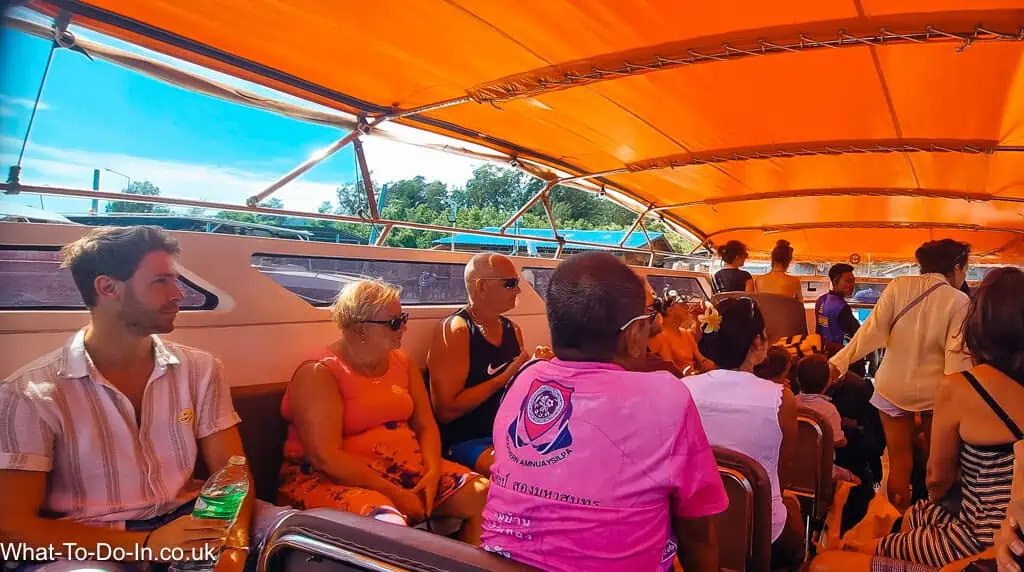
Krabi to Koh Lipe
Krabi is the one of main travel hubs in southern Thailand. We have always found it easy and simple to arrange travel in and out of Krabi. There are regular and frequent flights and ferries from all regions of Thailand and neighbouring countries. There’s also plenty of companies offering shuttle services, taxis and car hire. Getting to Koh Lipe from Krabi is possible in a number of ways.
1. Direct Ferry/Speedboat
- Seasonal Availability: Direct ferries and speedboats operate mainly during the high season (November to April) when the sea conditions are favourable. This direct route is the most straightforward way to reach Koh Lipe from Krabi.
- Journey Time: The direct journey can take between 2.5 to 5 hours, depending on the type of boat and weather conditions. However, although your tickets may say you are going directly to Koh Lipe you may find that in reality you may stop at islands alone the route and change boat.
- Departure Points: You can catch a ferry to Koh Lipe from the Klong Jilad Pier in Krabi.
2. Car Transfer to Pak Bara Pier
- From Krabi Airport: If you’re arriving by air, you can use a prebooked car transfer service directly to Pak Bara Pier. It’s advisable to arrange this in advance, especially during peak travel season. Taxis are also available at the airport. While more expensive than other options, they offer the convenience of direct, hassle-free travel to the pier. Always confirm the price before departure.
- Once at Pak Bara Pier, you’ll have to cross the sea for the final leg of your journey to Koh Lipe. Speedboat and ferry options are both available, with speedboats being faster but more expensive.
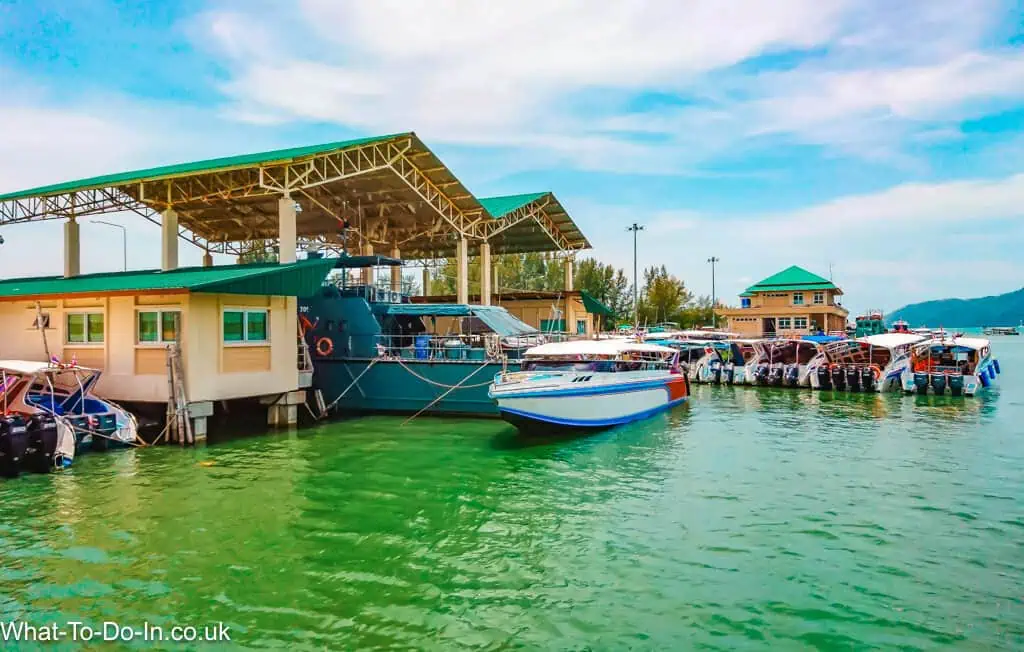
3. Via Trang or Hat Yai
Outside the high season or for additional schedule options, you can travel via Trang or Hat Yai.
- Bus or Minivan to Trang/Hat Yai: First, take a bus or minivan from Krabi to Trang or Hat Yai. This leg of the journey can take 3-4 hours to Trang and about 5 hours to Hat Yai.
- Transfer to Pak Bara Pier: From Trang or Hat Yai, continue by minivan or bus to Pak Bara Pier, the main departure point for boats to Koh Lipe.
- Ferry or Speedboat to Koh Lipe: From Pak Bara Pier, take a ferry or speedboat to Koh Lipe. The boat ride takes about 1.5 hours by speedboat and slightly longer by ferry.
4. Via Koh Lanta (Seasonal)
- Ferry to Koh Lanta: During the high season, you can take a ferry from Krabi to Koh Lanta.
- Connecting Ferry to Koh Lipe: You can catch a connecting ferry to Koh Lipe from Koh Lanta. This option allows for a stopover on Koh Lanta but requires careful planning to match the ferry schedules.
Passengers climbing onboard a speedboat at Sala Dan Pier, Koh Lanta
Phuket, Phi Phi and Koh Lanta to Koh Lipe
The main way to get from the islands of Phuket, Phi Phi and Koh Lanta to Koh Lipe is by boat. Although the tickets offered to go from Phuket and Phi Phi may say they go directly to Koh Lipe, in reality, you will probably stop at Koh Lanta and transfer to a different boat. Some of the ferry services from Koh Lanta may also stop at islands along the way.
From Phuket to Koh Lipe
- Ferry/Speedboat: During the high season (November to April), there are ferries and speedboats from Phuket to Koh Lipe. Rassada Pier is the departure point for ferries and speedboats heading to the island during the high season. The trip can take approximately 5-7 hours, depending on the service and weather conditions. This is the most straightforward option.
- Via Hat Yai: An alternative year-round route involves flying or taking a bus from Phuket to Hat Yai, followed by a minivan transfer to Pak Bara Pier and then a speedboat or ferry to Koh Lipe.
From Phi Phi to Koh Lipe
- Direct Ferry: Ferries connect Phi Phi Island with Koh Lipe in the high season. The journey takes about 3-4 hours and is a convenient way to travel between these islands without returning to the mainland.
- Via Krabi or Trang: Outside of the high season, you can take a ferry from Phi Phi to Krabi or Trang, then transfer by road to Pak Bara Pier, and continue by speedboat or ferry to Koh Lipe.
From Koh Lanta to Koh Lipe
- Direct Ferry/Speedboat: Several direct ferry and speedboat services are available from Koh Lanta to Koh Lipe during the high season. You catch your boat to Koh Lipe from the Saladan Pier. This route takes about 2.5 hours if it is non-stop and is the most direct way to travel between the islands. However, you may divert to stop at one or more islands along the way, making your journey longer.
- Via Pak Bara Pier: Alternatively, you can take a minivan or bus from Koh Lanta to Pak Bara Pier during the off-season, followed by a ferry or speedboat to Koh Lipe.
Koh Kradan, Koh Muk, and Koh Ngai to Koh Lipe
These islands lie between Koh Lanta and Koh Lipe. Boats often stop here in high season. If you find travelling by boat difficult, staying on one of these islands for a day or two can break up the journey and make it more bearable.
Departure Points:
- Koh Kradan: Departures are from the beach, as the island doesn’t have a pier. Instead, there is a blue, floating jetty.
- Koh Muk: Ferries and speedboats depart from the pier near the village.
- Koh Ngai: Departures are directly from the beach in front of the resorts.
How long it will take you to get to Koh Lipe varies, but it usually takes between 2 and 3 hours. The size of your boat, how good the weather is and how many other islands you stop at will affect the length of your journey.
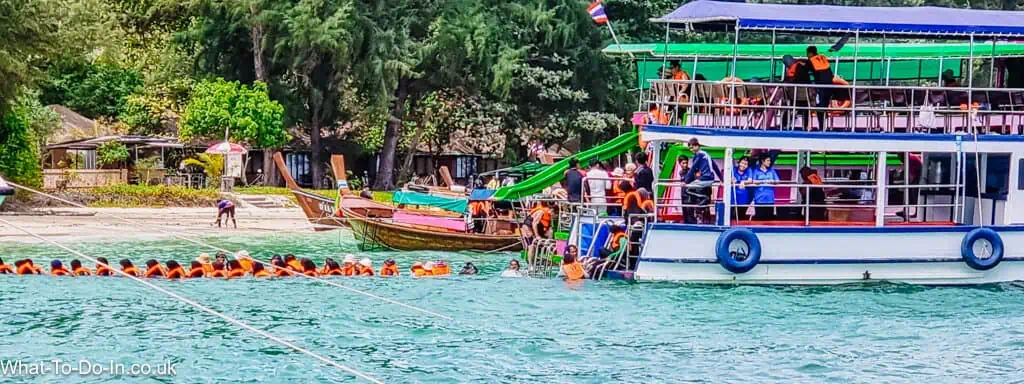
How to Get to Koh Lipe From Malaysia
Koh Lipe is about 30 kilometres or 18.5 miles from the Malaysian island of Langkawi. The closest point of the Malaysian mainland is 60 kilometres or 37 miles away at Kuala Perlis.
Before leaving Malaysia, you will need to go to the Immigration Office at the ferry terminal. You will fill in an arrival card and get a departure stamp on your passport there. Before getting on the ferry, your passport will be collected. When you arrive at Koh Lipe, all the passports will be given to the Immigration Office on Pattaya Beach. You then collect your passport from the Immigration Office. How long this takes can vary depending on how busy it is, but typically, it is less than an hour. There is no waiting room, so you sit on the beach. There’s little shade, but there are plenty of bars and restaurants in the area to get a drink and a seat.
Langkawi to Koh Lipe
Langkawi is an archipelago in Malaysia known for its breathtaking beaches and stunning rainforests. As they are close together and easy to travel between, travellers often visit Langkawi and Koh Lipe together.
1. Direct Ferry/Speedboat Service
- Seasonal Operation: The direct ferries or speedboats between Langkawi and Koh Lipe operate mainly during the high season, which runs from November to April.
- Travel Time: The direct journey takes about 1.5 hours, making this the quickest ferry journey to Koh Lipe.
- Departure Points: Ferries depart from Telaga Harbour Marina or Kuah Jetty from Langkawi. You must double-check your ticket and departure point to ensure you go to the right pier.
- Immigration Procedures: Since this is an international crossing, you must go through Immigration. In Langkawi, you need to go to the Immigration Office to fill out your paperwork before boarding. Your passport will be given to the ferry staff. Upon arrival in Koh Lipe, all passports are passed to the Immigration Office on Pattaya Beach, and you collect your passport from there.
2. Private Boat Charter
- Flexibility: Private boat charters are available if you are looking for a more personalised travel experience or travelling outside the regular ferry operation season. This option offers flexibility in terms of timing and can be a luxurious way to travel.
- Cost: Chartering a private boat is significantly more expensive than taking the public ferry or speedboat but can be cost-effective for larger groups or for those seeking a unique experience.
Singapore to Koh Lipe
Travelling from Singapore to Koh Lipe involves a combination of air, land, and sea transport due to the island’s remote location in the Andaman Sea. Combining a stay on Koh Lipe with time in Singapore would provide an interesting contrast. My Dad spent five days in Singapore and while he found it a fascinating place to explore he also found the constant hustle and bustle of the city tiring. Spending some time recharging his batteries on a beach in Koh Lipe would have been very welcome.
1. Flight to Hat Yai or Langkawi + Ferry/Speedboat
The most common and time-efficient way to reach Koh Lipe from Singapore involves flying to one of the nearby airports and then taking a ferry or speedboat to the island. You will be crossing an international border.
-
- Hat Yai: Fly from Singapore to Hat Yai International Airport in Thailand. From Hat Yai, then take a minivan or bus to Pak Bara Pier (approximately 2 hours), followed by a speedboat or ferry to Koh Lipe (around 1.5 hours).
- Langkawi: Fly from Singapore to Langkawi International Airport in Malaysia. During the high season (November to April), take a direct ferry from Langkawi to Koh Lipe (about 1.5 hours).
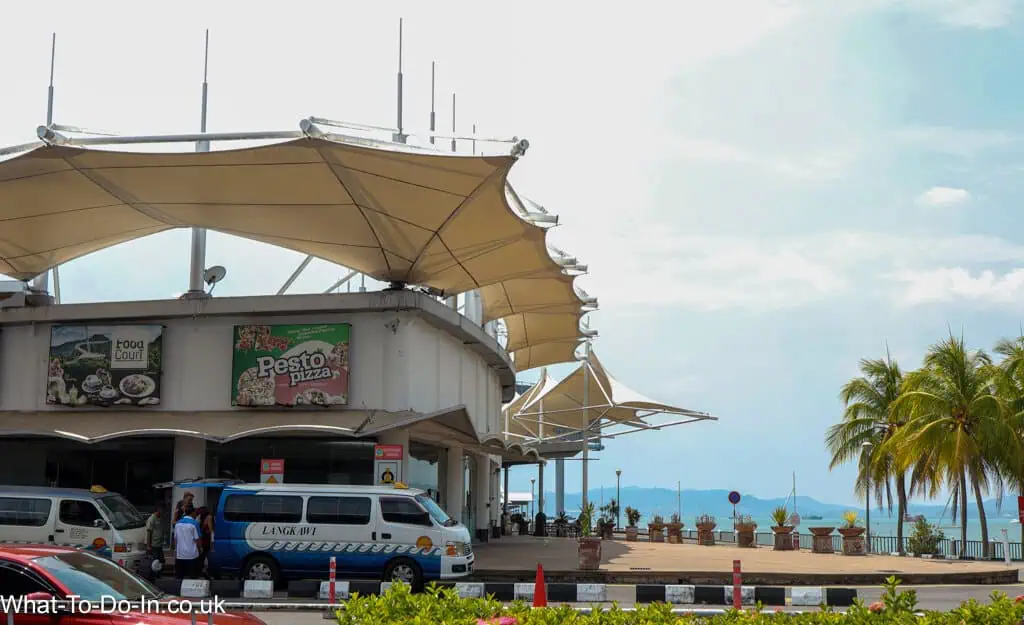
2. Bus + Ferry/Speedboat
If you prefer land travel or want a more budget-friendly option, you can take a bus from Singapore to one of the departure points in Thailand or Malaysia, followed by a ferry or speedboat to Koh Lipe.
- Bus to Hat Yai: You can get a long-distance bus from Singapore to Hat Yai, which can take 12 hours or more. From Hat Yai, proceed with the minivan or bus to Pak Bara Pier and then take a ferry or speedboat to Koh Lipe.
- Bus to Kuala Lumpur + Flight to Langkawi: Alternatively, take a bus to Kuala Lumpur and then a short flight to Langkawi. Catch the direct ferry to Koh Lipe from Langkawi during the high season.
3. Train + Ferry/Speedboat
An adventurous but less common route involves taking a train from Singapore to Hat Yai, followed by the ferry or speedboat connection to Koh Lipe.
- Train to Hat Yai: Take a train from Singapore to Hat Yai, which involves a transfer at the Malaysia-Thailand border. From Hat Yai, continue as described above to Pak Bara Pier and then to Koh Lipe.
Penang to Koh Lipe
Penang is a popular departure point from Malysia to Koh Lipe. If we decided to spend some time in Malysia then I think Penang would be my choice of destination. Understandably, many tourists like to combine visiting Penang with Koh Lipe.
1. Direct Ferry Service (Seasonal)
- During the high season (typically from November to April), there are direct ferry services from Penang to Koh Lipe. This is the most straightforward and time-efficient option, taking approximately 3 to 4 hours.
- Checking the ferry schedule in advance is essential as services are seasonal and subject to weather conditions.
2. Via Langkawi
Another popular route involves travelling to Langkawi first and then catching a ferry to Koh Lipe.
- Ferry or Flight to Langkawi: You can take a ferry or a short domestic flight from Penang to Langkawi. The ferry takes around 2.5 to 3 hours, while flights are quicker but may require additional time for airport procedures.
- Ferry from Langkawi to Koh Lipe: From Langkawi, take a direct ferry to Koh Lipe. This leg of the journey typically takes about 1.5 hours, with departures mainly during the high season.
3. Via Hat Yai
For a more adventurous route or outside the direct ferry operating season, you can travel via Hat Yai in Thailand.
- Bus or Train to Hat Yai: Take a bus or train from Penang to Hat Yai. The journey can take anywhere from 4 to 6 hours, depending on the mode of transport and border crossing time.
- Minivan to Pak Bara Pier: From Hat Yai, continue with a minivan or bus to Pak Bara Pier, which takes about 2 hours.
- Ferry/Speedboat to Koh Lipe: From Pak Bara Pier, catch a ferry or speedboat to Koh Lipe. The sea journey takes approximately 1.5 hours by speedboat.
Ferry arrival point, Pattaya Beach, Koh Lipe
What to Expect When You Arrive in Koh Lipe
No matter which ferry service you use, you will arrive on Pattaya Beach. There is a bright blue floating pontoon pier that most of the boats tie up to in the centre of the bay. Slightly disconcertingly, when we were there in January 2024, the middle section of the pier was missing! The sea is relatively shallow around Pattaya Beach, and if the tides are very low and your boat is too big to reach the pier, you may have to disembark onto a floating platform and be ferried to land by a long-tail boat.
When you arrive on Pattaya Beach, you will see a desk where you must buy a Tarutao National Marine Park ticket. These cost 200 Baht for adults and 100 Baht for children 3-14 in January 2024. You should keep this ticket on you, especially if you are going to a different island, or you may end up paying twice.
Some resorts have a transport service, and they will meet you on Pattaya Beach and help you with your bags. If the place where you are staying does not provide this service, at the entrance of the Walking Street, you will find tuk-tuk taxis. On Koh Lipe, these usually have a sideways bench, so you sit facing the driver. A taxi ride in a sidecar tuk-tuk will cost you a fixed rate of 100 baht regardless of where you are going. You could take a boat taxi if your hotel is on the coast. A short trip in a long-tail boat will cost you 100 baht per person. Alternatively, you could walk as Koh Lipe is a tiny island, and where you are staying may be nearby.
Travel Tips
These are our top tips for visiting Koh Lipe. Some are things we learned along the way, and others are advice more experienced travellers gave us.
Prebook
Koh Lipe is growing in popularity, so prebooking your tickets and accommodation would be advisable. We find these websites useful for booking boats:
You can also book directly with the ferry companies:
Passports and Visas
Unless you are a local, you will need passports and visas. Especially if you are going to Koh Lipe from Langkawi, you will have to go through Immigration. It is essential to check when the Immigration Office you need is open and leave plenty of time in case it is busy. Often, there is only one ferry a day to Koh Lipe, so if you miss it because you haven’t got your paperwork done in time, you will have to wait until the next day.
If you are near the end of your visa, you will not be able to extend it on Koh Lipe. If Koh Lipe is your first stop in Thailand, you must have over six months left on your passport and evidence of how you are leaving the country.
Prepare for Your Journey
As you can see, it can be challenging to get to Koh Lipe. You may have to change between modes of transport and spend time waiting between legs of your journey. At some point, you will have to travel by boat. Things to consider include:
- Suitable clothing: You will probably get hot and sweaty at some point on your journey. It is always possible that you may get wet when you are on a boat. If you are sitting around waiting during a layover, you will either be outside in the hot sun or inside in air-conditioning. So think about what you will wear and consider having layers you can add and remove when needed.
- Pack sensibly: Any big bags will be carried on board for you by the ferry staff. They will be piled up at the front of the boat and taken off when you arrive. Don’t put anything breakable in a soft-sided bag. You can keep a small bag or backpack on your knee or by your feet. It would be sensible to keep your valuables and breakables with you. However, getting on the boat and along the floating piers can be slippery and unstable, so you want to have a manageable bag. We always put our electronics in a waterproof bag as there is always a chance your bags may get wet.
- Plan your food and drink: On a long, hot journey, you need plenty of fluids. You may also want something to eat. The speedboats do not give you a comfortable ride, so if you get at all travel sick, it would be advisable to skip breakfast. Mint or ginger sweets can help counteract the engine smell and keep your energy levels up. Travel bands, herbal patches and antinausea tablets are also sensible precautions.
- Expect to be uncomfortable: The speedboats are noisy, smelly and bouncy. When you are in the open sea, you will occasionally slam painfully into a wave, no matter how good the weather or how skilled your pilot is. In bad weather and a small boat, your journey time can double, and you will constantly be crashing into waves. The nearer you sit to the front, the more air you will have and less engine smell, but you will feel the impact of hitting the waves more. The further back you sit, you have less air and more diesel fumes, but you feel the effects of the waves slightly less. Earplugs or noise-cancelling headphones can help with the noise. Some people wear neck support cushions. There will be life jackets on your seats, and you can use these to sit on or put behind your back to give extra cushioning.
- Expect to be bored: Travelling through the Andaman Sea past the beautiful islands sounds idyllic. In reality, you can’t see anything while sitting down. Depending on how close together your seats are, you may be able to stand up, but it isn’t a practical option when the speedboat is going fast. You have to shout for the person sitting next to you to hear, so conversation is impossible. As a result, a speedboat trip can be incredibly boring. Some people, including Aidan, manage to doze off despite the discomfort!
- Don’t rely on the timetable to be accurate: You are very unlikely to arrive or depart at the time on your ticket. You are usually required to check in an hour before your departure time, but you will likely find the check-in desk isn’t open until half an hour before you leave. Even if the ticket you have booked says it is a direct route, you may still stop at several islands along the way. If you are travelling when the weather is bad, your trip will take longer.
- Trust the staff: Working out which boat you should be on and where your luggage can be a little stressful. When you ask staff at the piers, you often get vague answers. However, in our experience, the ferry staff are very organised and efficient. When you check-in, you write your name on a list and are given a sticker with a number and your destination. The ferry staff always check they have everyone before they leave. The pilots are highly skilled and do everything possible to give you a smooth and safe journey. We were very impressed with how well they handled the boat, especially during the trip we had terrible weather.
Check-in desk for the ferry on Pattaya Beach
Travel Insurance
Make sure you have travel insurance that covers all of your journey. Double-check your insurance covers the length of your trip if you are away for more than 30 days. Read the small print to see what help you get if you lose your luggage at any point. I always make sure to have my contact lenses and glasses, my medication and a change of underwear in the bag I keep with me, just in case.
FAQ
These are some of the coomon queries people have when planning to travel to Koh Lipe:
1. What is the nearest airport to Koh Lipe?
Langkawi International Airport, Malaysia, is the nearest airport to Koh Lipe. You will have to go through Immigration as you will cross the Thai/Malaysia border and then travel by boat for about 1.5 hours. You can also fly into Hat Yai International Airport or Trang Airport in Thailand. You would then need to travel by road to Pak Bara Pier and then by boat for about 1.5 hours.
2. How long is the ferry ride to Koh Lipe?
The shortest ferry rides to Koh Lipe are from either Langkawi, Malaysia or Pak Bara Pier, Thailand. It takes about 1.5 hours from both these ports. If you travel from Koh Lanta, it will take a minimum of 2.5 hours in good weather with no stops at other islands.
3. How long is the ferry from Phuket to Koh Lipe?
It takes at least 5 hours to travel from Phuket to Koh Lipe. Even ‘direct’ tickets will involve changing boats at least once. You may also find that your ferry stops at islands along the way, increasing travel time. High winds and bad weather will also make your ferry trip longer.
4. How do I get to Koh Lipe from Bangkok?
From Bangkok, you can fly to Hat Yai or Trang, then take a minivan to Pak Bara Pier and catch a speedboat or ferry to Koh Lipe. Alternatively, you can use bus or train services to reach Pak Bara for the sea crossing.
5. Can I get a ferry directly from Langkawi to Koh Lipe?
Yes, direct ferries from Langkawi to Koh Lipe operate during the high season (November to April), taking about 1.5 hours. Allow time to go through immigration procedures before departure.
6. What is the National Park fee charged for visiting Koh Lipe?
Visitors to Koh Lipe are required to pay a National Park fee to support conservation efforts within the Tarutao National Marine Park. The cost is 200 Baht for adults and 100 Baht for children aged 3-14 years, payable upon arrival at Pattaya Beach.
7. Can I travel to Koh Lipe outside the peak season of November to April?
Yes, travel to Koh Lipe is possible year-round via Pak Bara Pier, where speedboats operate even during the low season (May to October), though less frequently.
8. Is a trip to Koh Lipe worth it?
Absolutely. Despite its more remote location and potentially lengthy and challenging journey, Koh Lipe’s exceptional scenery and relaxed atmosphere offer a distinct experience compared to Thailand’s more accessible islands.
9. How long should I stay in Koh Lipe?
A minimum stay of four days is recommended to fully enjoy Koh Lipe, accounting for travel time to and from the island. Consider extending your stay to relax after the journey, explore snorkelling spots, and visit nearby Ko Adang.
10. Can you party on Koh Lipe?
Koh Lipe is not predominantly a party destination. While it hosts beach bars along Sunrise Beach and livelier venues on Walking Street and Pattaya Beach, the nightlife is generally laid-back, with Full Moon Parties at Zodiac Bar offering a more relaxed vibe.
11. Are there ATMs available on Koh Lipe?
Several ATMs are available on Koh Lipe but be prepared for possible outages and higher transaction fees. Bringing sufficient cash with you is advisable.

